Homeowner Tips Home for the Holidays - How Families Celebrate the Season

Regardless of what you celebrate, winter is the season of festivities, connection, and gratitude. Holidays bring the whole family together in a shared space. Every family has a different idea of what home is and will create a space to emulate the meaning of family. Let’s take a look at the different ways that people celebrate the holidays and spend time with family.
Hanukkah Tradition
The celebration of Hanukkah traditionally commemorates the reclaiming of the Temple of Jerusalem from the Greeks in the 2nd century BCE. This celebration lasts eight days and nights and consists of prayer, feasts, and games.
Traditionally, Hanukkah is not an ornamental holiday; In fact, most Jewish families shy away from decorating altogether. However, more modern families may celebrate Hanukkah with blue and white lights, tinsel, and wreaths, but most stick to a single lit menorah. Instead of decorating, Jewish families celebrate by lighting a candle on the Menorah each night of Hanukkah.
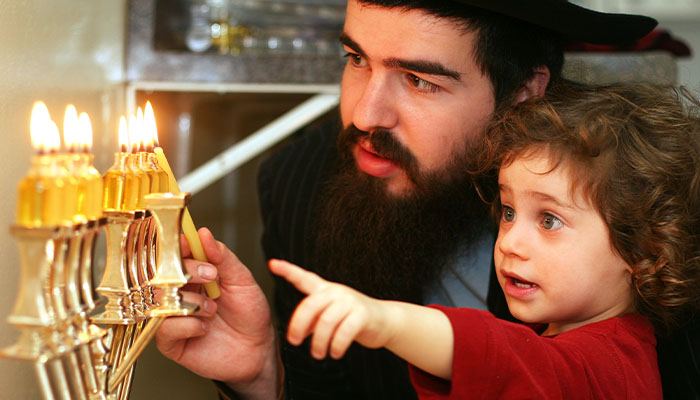
Lighting the Menorah
The Menorah has an ancient origin; it is told that after the Israelites escaped slavery in Egypt, God commanded them to create the first Menorah from olive branches to represent a new way of life. The original Menorah holds seven candles to symbolize the seven days of creation. However, Hanukkah Menorahs typically have eight candleholders, with one additional candle above the rest: the Shamash, which is used to light the other candles. The eight candles represent the miracle story where a single candle burned for eight days with only a day’s supply of oil.
The lighting of the Menorah is one of the holiest aspects of Hanukkah. Families light a candle at night after the sun sets or whenever the entire family is present. The Menorah is usually displayed in a window or as a centerpiece to remind others of the holiday’s miracle. Various Hanukkah blessings accompany the lighting.
Hanukkah Feasts and Festivities
Although this holiday lacks decor, Hanukkah consists of plenty of delicious traditional foods and fun games to create a welcoming and festive atmosphere. Food is often fried in oil as another allusion to the holiday miracle. Families may enjoy potato pancakes, commonly known as latkes, and sufganiyot, which are jam-filled donuts.

A common game played during Hanukkah is Dreidel. Historically, the Jewish people were not allowed to practice Judaism under Greek rule; however, they hid their practices by playing dreidel when in the presence of the Greeks. Today, families play Dreidel during Hanukkah to commemorate their ancestors.
Kwanzaa Tradition
Kwanzaa in itself is not a religious holiday, but one that celebrates African family and social values. The holiday was created in 1966 by a professor of African studies named Maulana Karenga. Kwanzaa is observed mainly by African Americans living in America, but is also celebrated by families in the Caribbean and other countries with a large population of African descendants. Kwanzaa is a seven day holiday symbolizing the seven principles of Kwanzaa:
- Unity (umoja)
- Self-determination (kujichagulia)
- Collective responsibility (ujima)
- Cooperative economics (ujamaa)
- Purpose (nia)
- Creativity (kuumba)
- Faith (imani)
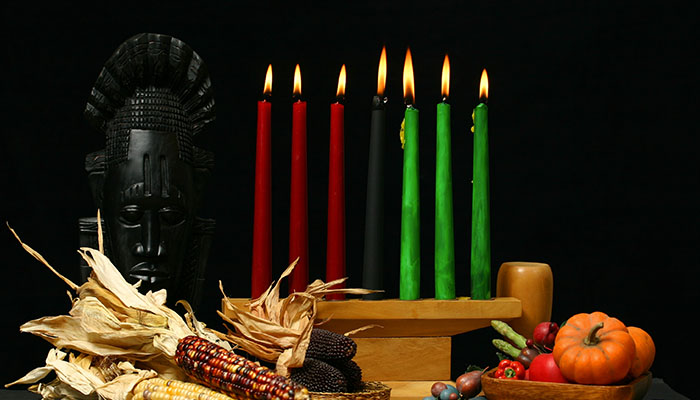
There are also seven symbols of Kwanzaa that commemorate the holiday:
- Fruits, vegetables, and nuts
- A straw mat
- A candleholder
- Ears of corn (maize)
- Gifts
- A communal cup signifying unity
- Te Kinara, which holds seven candles in the African colors of red, green, and black.
Lighting the Kinara
Like the Jewish Menorah, the Kinara is a seven-candle candelabra lit each night of Kwanzaa. Each candle represents one of the seven principles. Families light a single candle each night and discuss what the principle means to them as a family.
When setting up the Kinara display, a straw mat called the Mkeka is laid down, then an ear of corn is placed for each child. Next, families place the cup of unity, or kikombe cha umoja, on the straw mat; water fills this cup each night of Kwanzaa. Lastly,, African fruits and vegetables are displayed to observe their heritage. The Kinara sits in the center of the mat to finish the display. Additionally, families may choose to adorn the Mkeka with African art.
Kwanzaa Feasts and Festivities
Unlike Hanukkah, Kwanzaa is a much more decorated holiday. Families choose to embellish their homes with African art, the traditional colors of Africa, dried corn, and fruits and vegetables. Hand-woven African blankets may also be used to liven the home.
When it’s time to eat, families will make dishes influenced by sub-Saharan Africa, the Caribbean, and southern soul, but there are no rules to the food. A popular dish, however, is a one-pot stew, which may take hours to complete. The most important rule about Kwanzaa dinner is that it is shared; Kwanzaa at its heart is a holiday about community.
The Kwanzaa celebration is known for its lively music, dancing, and festivities. Large cities all around America celebrate Kwanzaa with big festivals and performances where anyone can learn about the vast African heritage. Additionally, African museums across the country may offer learning events specifically dedicated to the holiday.
Christmas Traditions
Although most people are familiar with the significance of Christmas in the Christian faith, most don’t know how or when the celebration of Christmas actually became a worldwide holiday. Before the arrival of Jesus, modern-day Europeans rejoiced during the winter solstice when the worst of winter had already passed. They looked forward to longer days with more sunlight.
Historically, the Norse celebrated Yule from the winter solstice through January. It was custom for the males to bring home large logs to set on fire – the yule log. The feast lasted until the logs burned out and every spark from the fire represented new pigs and calves that would be born the following year.
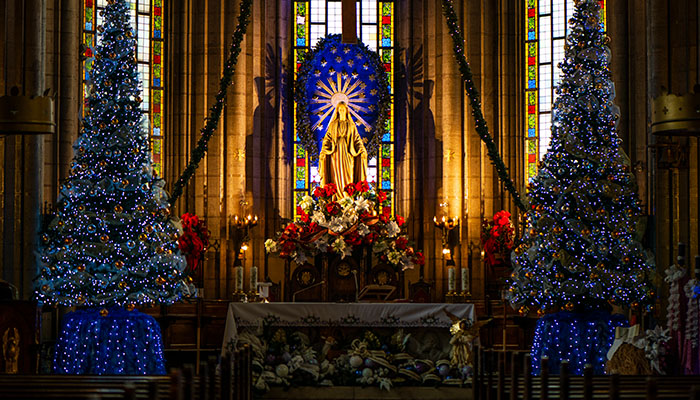
As Christianity gained popularity, churches held Christmas celebrations around the same time as the winter solstice to increase participation from pagan followers.
Christmas in America
During the early 17th century, Puritan beliefs spread throughout England under commander-in-chief Oliver Cromwell, and Christian beliefs were tossed aside.
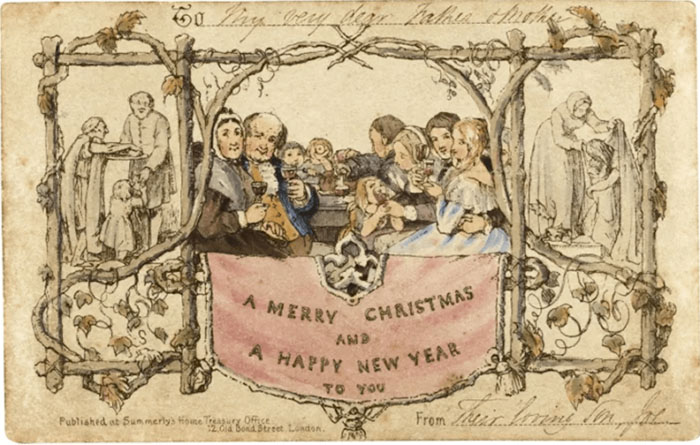
Around the same time, English separatists voyaged to the Americas with their orthodox Puritan ideals. Christmas was not a celebrated holiday and was actually outlawed in Boston from 1659 to 1681; anyone who celebrated would be fined 5 shillings. However, colonists rejected English customs after the American Revolution, and Christmas was declared a holiday on June 26, 1870.
The Re-Invention of Christmas
Christmas was previously celebrated with large street carnivals, but by the 1800s, it was transformed into a family-centered day of peace and nostalgia. This transformation can be attributed to the Christmas riot in 1828 where upper-class Americans saw the risks and wanted to turn Christmas into an age-oriented and peaceful holiday.
A significant catalyst, Charles Dickens, wrote his famous novel, A Christmas Carol, which struck a chord with Americans as the classic holiday tale of family and love.
The Introduction of Santa Claus
As Americans embraced this new Christmas, attention fell to the involvement of children in the holiday. The story of Santa Claus comes from the legend of St. Nicholas from Turkey in 280 AD. St. Nicholas famously gave his inherited wealth to the poor and sick families in the countryside.
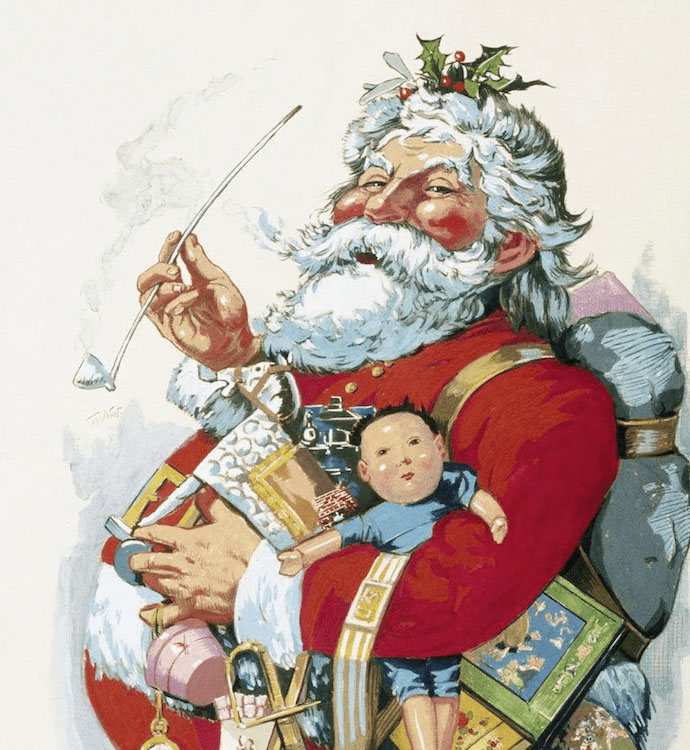
In the late 18th century, Dutch families in New York gathered to honor the death of Sint Nikolaas. An Episcopal minister named Clement Clark Moore wrote a Christmas poem whose first line started with, Twas The Night Before Christmas. This poem tells the story of Santa Claus as a jolly man who delivers gifts by reindeer on Christmas Eve. The red-cloaked Santa we know today was immortalized in an 1881 cartoon by political cartoonist Thomas Nast.
Happy Holidays from HomeHunt!
During the holidays, your home is the center of gratitude, fellowship, and love. It’s the place where the family comes together to feel a sense of unity, no matter what you celebrate. Contact HomeHunt today to find the perfect home for you and your loved ones to reunite during the holidays!